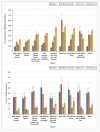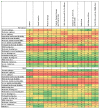Global Burden of Childhood Epilepsy, Intellectual Disability, and Sensory Impairments
- PMID: 32554521
- PMCID: PMC7613313
- DOI: 10.1542/peds.2019-2623
Global Burden of Childhood Epilepsy, Intellectual Disability, and Sensory Impairments
Abstract
Background: Estimates of children and adolescents with disabilities worldwide are needed to inform global intervention under the disability-inclusive provisions of the Sustainable Development Goals. We sought to update the most widely reported estimate of 93 million children <15 years with disabilities from the Global Burden of Disease Study 2004.
Methods: We analyzed Global Burden of Disease Study 2017 data on the prevalence of childhood epilepsy, intellectual disability, and vision or hearing loss and on years lived with disability (YLD) derived from systematic reviews, health surveys, hospital and claims databases, cohort studies, and disease-specific registries. Point estimates of the prevalence and YLD and the 95% uncertainty intervals (UIs) around the estimates were assessed.
Results: Globally, 291.2 million (11.2%) of the 2.6 billion children and adolescents (95% UI: 249.9-335.4 million) were estimated to have 1 of the 4 specified disabilities in 2017. The prevalence of these disabilities increased with age from 6.1% among children aged <1 year to 13.9% among adolescents aged 15 to 19 years. A total of 275.2 million (94.5%) lived in low- and middle-income countries, predominantly in South Asia and sub-Saharan Africa. The top 10 countries accounted for 62.3% of all children and adolescents with disabilities. These disabilities accounted for 28.9 million YLD or 19.9% of the overall 145.3 million (95% UI: 106.9-189.7) YLD from all causes among children and adolescents.
Conclusions: The number of children and adolescents with these 4 disabilities is far higher than the 2004 estimate, increases from infancy to adolescence, and accounts for a substantial proportion of all-cause YLD.
Copyright © 2020 by the American Academy of Pediatrics.
Conflict of interest statement
POTENTIAL CONFLICT OF INTEREST: The authors have indicated they have no potential conflicts of interest to disclose.
Figures





Comment in
-
The Increasing Global Burden of Childhood Disability: A Call for Action.Pediatrics. 2020 Jul;146(1):e20201119. doi: 10.1542/peds.2020-1119. Epub 2020 Jun 17. Pediatrics. 2020. PMID: 32554519 No abstract available.
References
-
- United Nations. Sustainable Development Goals. New York, NY: United Nations; 2015. [Accessed July 30, 2019]. Available at: www.un.org/sustainabledevelopment/sustainable-development-goals/
-
- United Nations Children's Fund. The State of the World's Children 2013: Children With Disabilities. New York, NY: United Nations Children's Fund; 2013. [Accessed July 30, 2019]. Available at: https://www.unicef.org/sowc2013/files/SWCR2013_ENG_Lo_res_24_Apr_2013.pdf.
-
- World Health Organization; The World Bank. World Report on Disability. Geneva, Switzerland: World Health Organization; 2011. [Accessed July 30, 2019]. Available at: www.who.int/disabilities/world_report/2011/report.pdf.
-
- United Nations Educational, Scientific and Cultural Organization. Education and disability. [Accessed July 30, 2019]. Available at: http://uis.unesco.org/sites/default/files/documents/fs40-education-and-d....
-
- Male C, Wodon Q. The Price of Exclusion: Disability and Education: Disability Gaps in Educational Attainment and Literacy. Washington, DC: The World Bank; 2017. [Accessed July 30, 2019]. Available at: https://documents1.worldbank.org/curated/en/396291511988894028/pdf/12176....

